Impact of Temperature Changes and Freeze—Thaw Cycles on the Behaviour of Asphalt Concrete Submerged in Water with Sodium Chloride
Abstract
Highlights
1. Introduction
2. Methodology
2.1. Materials
2.1.1. Aggregate
2.1.2. Binder
2.1.3. Mixture
2.1.4. Salt
2.2. Experimental Plan
- Test Series A: remains at a constant temperature of 20 °C;
- Test Series B: subjected to five freeze–thaw cycles;
- Test Series C, subjected to one year outside storage;
- (A0) is dry specimens,
- (A1) is submerged in distilled water,
- (A2) is submerged in salt water,
2.2.1. Temperature Interaction
Freeze–Thaw Cycles
Outside Storage
2.3. Tests Programme
2.3.1. Indirect Tensile Strength (ITS) and Water Sensitivity Test (ITSR)
2.3.2. Wheel Tracking Test
2.3.3. Dynamic Modulus Test
2.3.4. Fatigue Test
3. Results and Discussion
3.1. Indirect Tensile Strength (ITS) and Water Sensitivity Test (ITSR)
3.2. Wheel Tracking Test
3.3. Dynamic Modulus Test
3.4. Fatigue Test
4. Conclusions
Author Contributions
Funding
Conflicts of Interest
References
- Bäckström, M.; Karlsson, S.; Bäckman, L.; Folkeson, L.; Lind, B. Mobilisation of heavy metals by deicing salts in a roadside environment. Water Res. 2003, 38, 720–732. [Google Scholar] [CrossRef] [PubMed]
- Norrström, A.C. Metal mobility by de-icing salt from an infiltration trench for highway runoff. Appl. Geochem. 2005, 20, 1907–1919. [Google Scholar] [CrossRef]
- Engelsen, C.J.; Wibetoe, G.; van der Sloot, H.A.; Lund, W.; Petkovic, G. Field site leaching from recycled concrete aggregates applied as sub-base material in road construction. Sci. Total Environ. 2012, 427–428, 86–97. [Google Scholar] [CrossRef] [PubMed]
- Norrström, A.C.; Jacks, G. Concentration and fractionation of heavy metals in roadside soils receiving de-icing salts. Sci. Total Environ. 1998, 218, 161–174. [Google Scholar] [CrossRef]
- Rivett, M.O.; Cuthbert, M.O.; Gamble, R.; Connon, L.E.; Pearson, A.; Shepley, M.G.; Davis, J. Highway deicing salt dynamic runoff to surface water and subsequent infiltration to groundwater during severe UK winters. Sci. Total Environ. 2016, 565, 324–338. [Google Scholar] [CrossRef] [PubMed]
- Snodgrass, J.W.; Moore, J.; Lev, S.M.; Casey, R.E.; Ownby, D.R.; Flora, R.F.; Izzo, G. Influence of Modern Stormwater Management Practices on Transport of Road Salt to Surface Waters. Environm. Sci. Technol. 2017, 51, 4165–4172. [Google Scholar] [CrossRef] [PubMed]
- García, L. Eficiencia en vialidad invernal. Materiales empleados en los trabajos para el mantenimiento de la vialidad invernal. In Proceedings of the XII Jornadas de Conservación de Carreteras, Madrid, Spain, 10–11 November 2010. [Google Scholar]
- Muthumani, A.; Fay, L.; Akin, M.; Wang, S.; Gong, J.; Shi, X. Correlating lab and field tests for evaluation of deicing and anti-icing chemicals: A review of potential approaches. Cold Reg. Sci. Technol. 2013, 97, 21–32. [Google Scholar] [CrossRef]
- Shi, X.; Veneziano, D.; Xie, N.; Gong, J. Use of chloride-based ice control products for sustainable winter maintenance: A balanced perspective. Cold Reg. Sci. Technol. 2013, 86, 104–112. [Google Scholar] [CrossRef]
- Klein-Paste, A.; Wåhlin, J. Wet pavement anti-icing—A physical mechanism. Cold Reg. Sci. Technol. 2013, 96, 1–7. [Google Scholar] [CrossRef]
- Ikiz, N.; Galip, E. Computerized decision tree for anti-icing/pretreatment applications as a result of laboratory and field testings. Cold Reg. Sci. Technol. 2016, 126, 90–108. [Google Scholar] [CrossRef]
- Trenouth, W.R.; Gharabaghi, B.; Perera, N. Road salt application planning tool for winter de-icing operations. J. Hydrol. 2015, 524, 401–410. [Google Scholar] [CrossRef]
- Wang, D.; Xie, X.; Oeser, M.; Steinauer, B. Influence of the gritting material applied during the winter services on the asphalt surface performance. Cold Reg. Sci. Technol. 2015, 112, 39–44. [Google Scholar] [CrossRef]
- Hassan, Y.; El Halim, A.O.A.; Razaqpur, A.G.; Bekheet, W.; Farha, M.H. Effects of Runway Deicers on Pavement Materials and Mixes: Comparison with Road Salt. J. Transp. Eng. 2012, 128, 385–391. [Google Scholar] [CrossRef]
- Feng, D.; Yi, J.; Wang, D.; Chen, L. Impact of salt and freeze–thaw cycles on performance of asphalt mixtures in coastal frozen region of China. Cold Reg. Sci. Technol. 2010, 62, 31–41. [Google Scholar] [CrossRef]
- Juli-Gándara, L.; Vega-Zamanillo, Á.; Calzada-Pérez, M.Á. Sodium chloride effect in the mechanical properties of the bituminous mixtures. Cold Reg. Sci. Technol. 2019, 164, 102776. [Google Scholar] [CrossRef]
- Goh, S.W.; You, Z. Evaluation of Hot-Mix Asphalt Distress under Rapid Freeze-Thaw Cycles using Image Processing Technique. In Proceedings of the 12th International Conference of Transportation Professionals (CICTP 2012), Beijing, China, 3–6 August 2012; pp. 3305–3315. [Google Scholar]
- Tarefder, R.; Faisal, H.; Barlas, G. Freeze-thaw effects on fatigue LIFE of hot mix asphalt and creep stiffness of asphalt binder. Cold Reg. Sci. Technol. 2018, 153, 197–207. [Google Scholar] [CrossRef]
- Özgan, E.; Serin, S. Investigation of certain engineering characteristics of asphalt concrete exposed to freeze-thaw cycles. Cold Reg. Sci. Technol. 2013, 85, 131–136. [Google Scholar] [CrossRef]
- Islam, M.R.; Tarefder, R.A. Effects of Large Freeze-Thaw Cycles on Stiffness and Tensile Strength of Asphalt Concrete. J. Cold Reg. Eng. 2016, 30, 06014006. [Google Scholar] [CrossRef]
- Teltayev, B.B.; Rossi, C.O.; Izmailova, G.G.; Amirbayev, E.D. Effect of Freeze Thaw Cycles on Mechanical Characteristics of Bitumen and Stone Mastic Asphalts. Appl. Sci. 2019, 9, 458. [Google Scholar] [CrossRef]
- UNE-EN 1097-2:2010. Tests for Mechanical and Physical Properties of aggregaTes—Part 2: Methods for the Determination of Resistance to Fragmentation; UNE: Madrid, Spain, 2010. [Google Scholar]
- UNE-EN 1097-6:2014. Tests for Mechanical and Physical Properties of Aggregates—Part 6: Determination of Particle Density and Water Absorption; UNE: Madrid, Spain, 2014. [Google Scholar]
- UNE-EN 933-3:2012. Tests for Geometrical Properties of Aggregates—Part 3: Determination of Particle Shape—Flakiness Index; UNE: Madrid, Spain, 2012. [Google Scholar]
- UNE-EN 1426:2015. Bitumen and Bituminous Binders. Determination of Needle Penetration; UNE: Madrid, Spain, 2015. [Google Scholar]
- UNE-EN 1427:2015. Bitumen and Bituminous Binders. Determination of the Softening Point. Ring and BALL Method; UNE: Madrid, Spain, 2015. [Google Scholar]
- UNE-EN 12593:2015. Bitumen and Bituminous Binders. Determination of the Fraass Breaking Point; UNE: Madrid, Spain, 2015. [Google Scholar]
- UNE-EN 12697-34:2013. Bituminous Mixtures—Test Methods for Hot Asphalt—Part 34: Marshall Test; UNE: Madrid, Spain, 2013. [Google Scholar]
- Pliego de Prescripciones Técnicas Generales para Obras de Carreteras y Puentes (PG-3). 2017. Available online: http://www.arquitectosdecadiz.com/wp-content/uploads/2017/12/PG3.pdf (accessed on 20 January 2020).
- UNE-EN 12697-12:2009. Bituminous Mixtures—Test Methods for Hot Mix Asphalt—Part 12: Determination of the Water Sensitivity of Bituminous Specimens; UNE: Madrid, Spain, 2009. [Google Scholar]
- UNE-EN 12697-30:2013. Bituminous Mixtures—Test Methods for Hot Mix Asphalt—Part 30: Specimen Preparation by Impact Compactor; UNE: Madrid, Spain, 2013. [Google Scholar]
- UNE-EN 12697-22:2008+A1:2008. Bituminous Mixtures—Test Methods for Hot Mix Asphalt—Part 22: Wheel Tracking; UNE: Madrid, Spain, 2008. [Google Scholar]
- UNE-EN 12697-33:2006+A1:2007. Bituminous Mixtures—Test Methods for Hot Mix Asphalt—Part 33: Specimen Prepared by Roller Compactor; UNE: Madrid, Spain, 2007. [Google Scholar]
- UNE-EN 12697-26:2012. Bituminous Mixtures—Test Methods for Hot Mix Asphalt—Part 26: Stiffness; UNE: Madrid, Spain, 2012. [Google Scholar]
- UNE-EN 12697-24:2013. Bituminous Mixtures—Test Methods for Hot Mix Asphalt—Part 24: Resistance to Fatigue; UNE: Madrid, Spain, 2013. [Google Scholar]
- Aleksandrov, A.A.; Dzhuraeva, E.V.; Utenkov, V.F. Thermal Conductivity of Sodium Chloride Aqueous Solutions. Therm. Eng. 2013, 60, 190–194. [Google Scholar] [CrossRef]
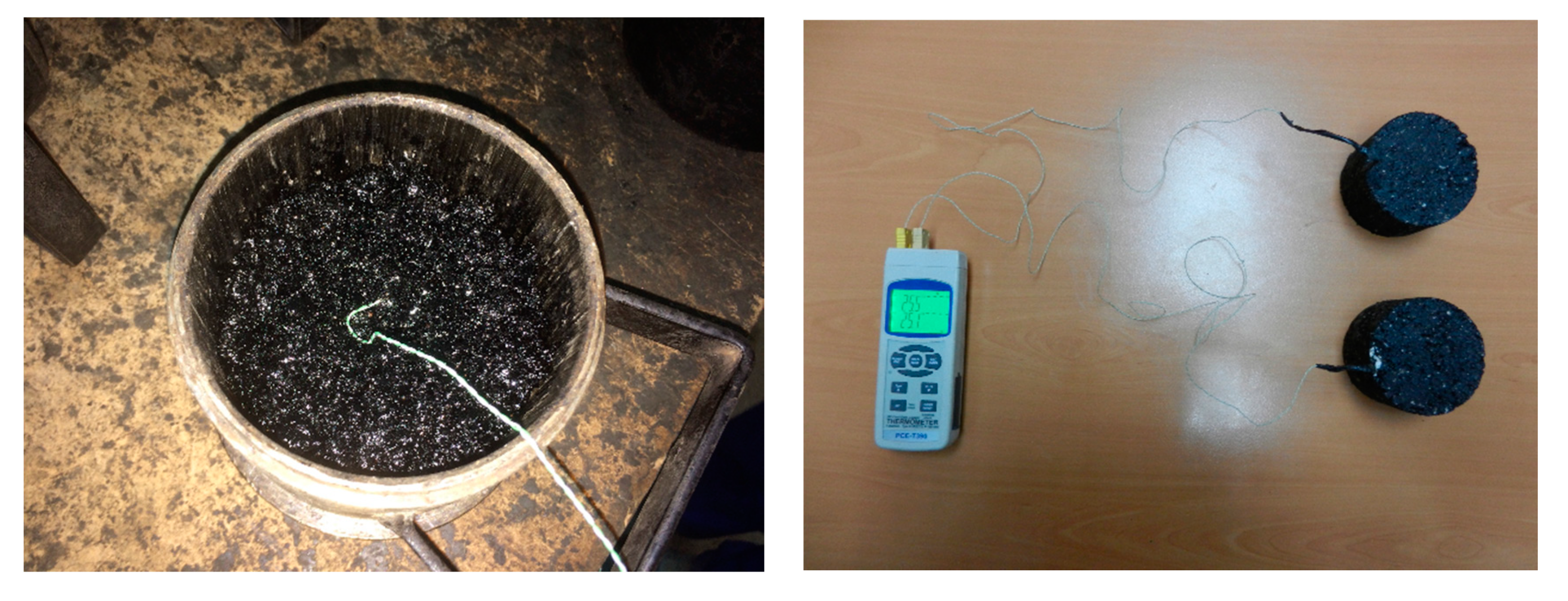
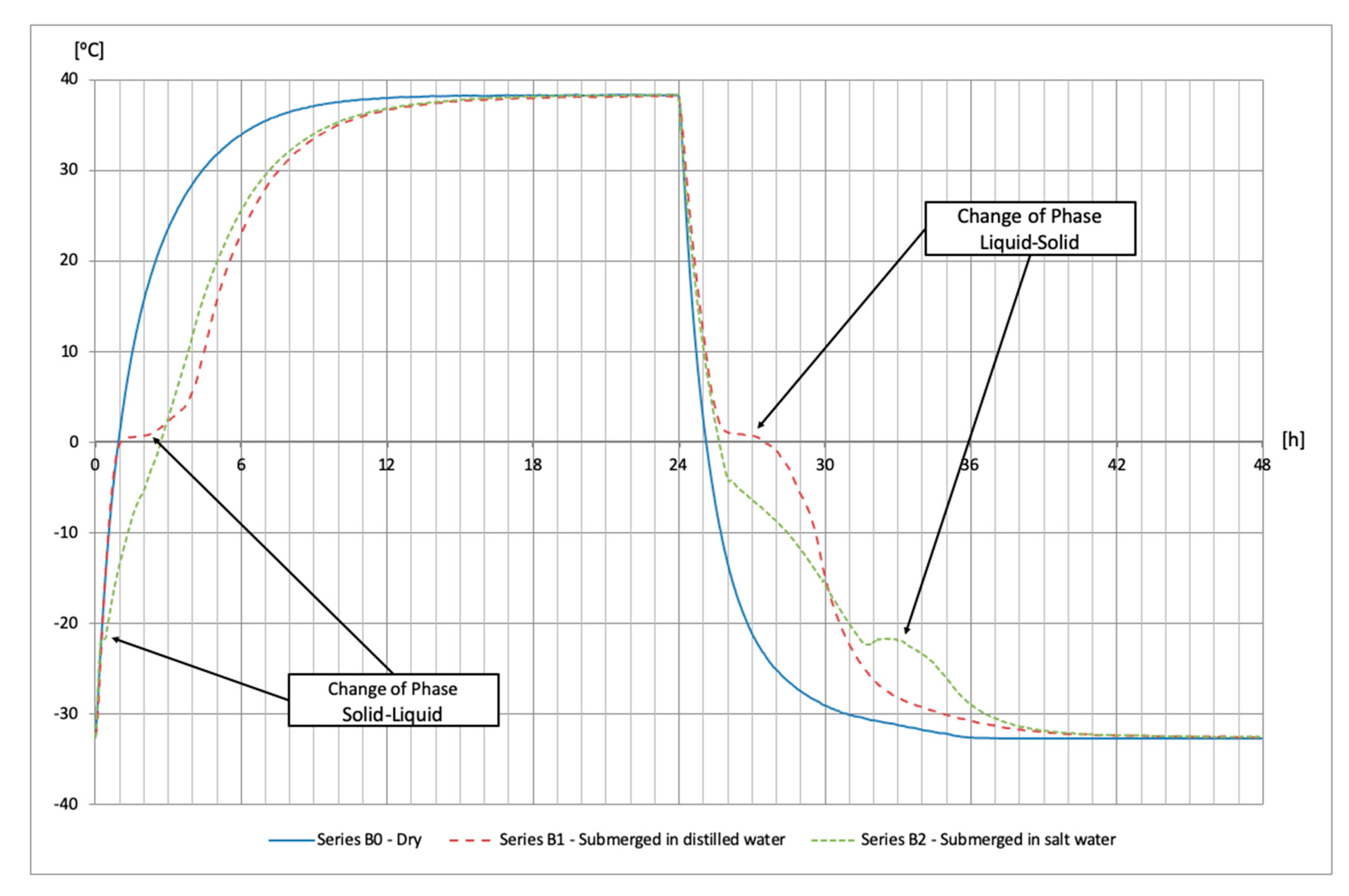
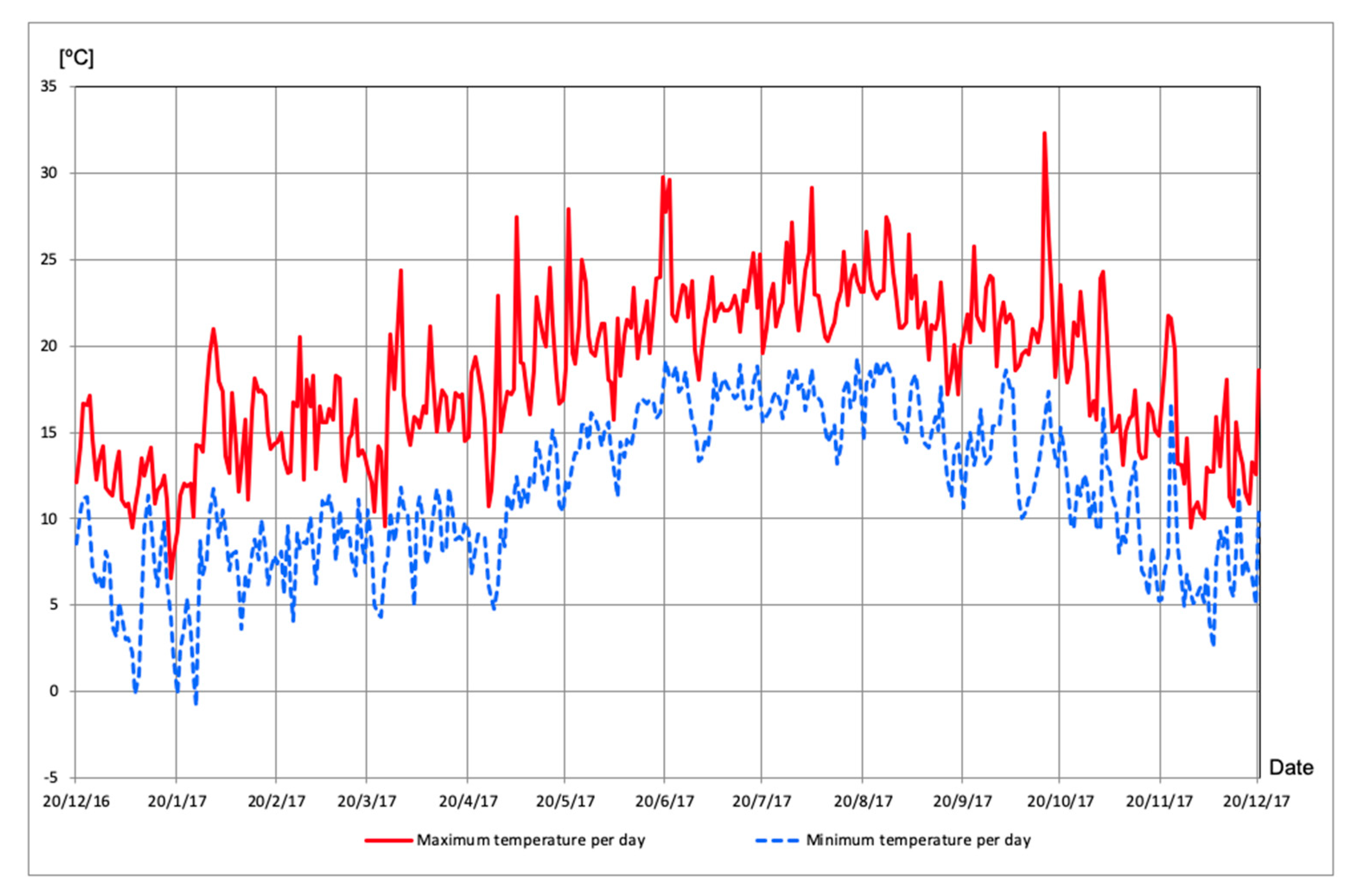
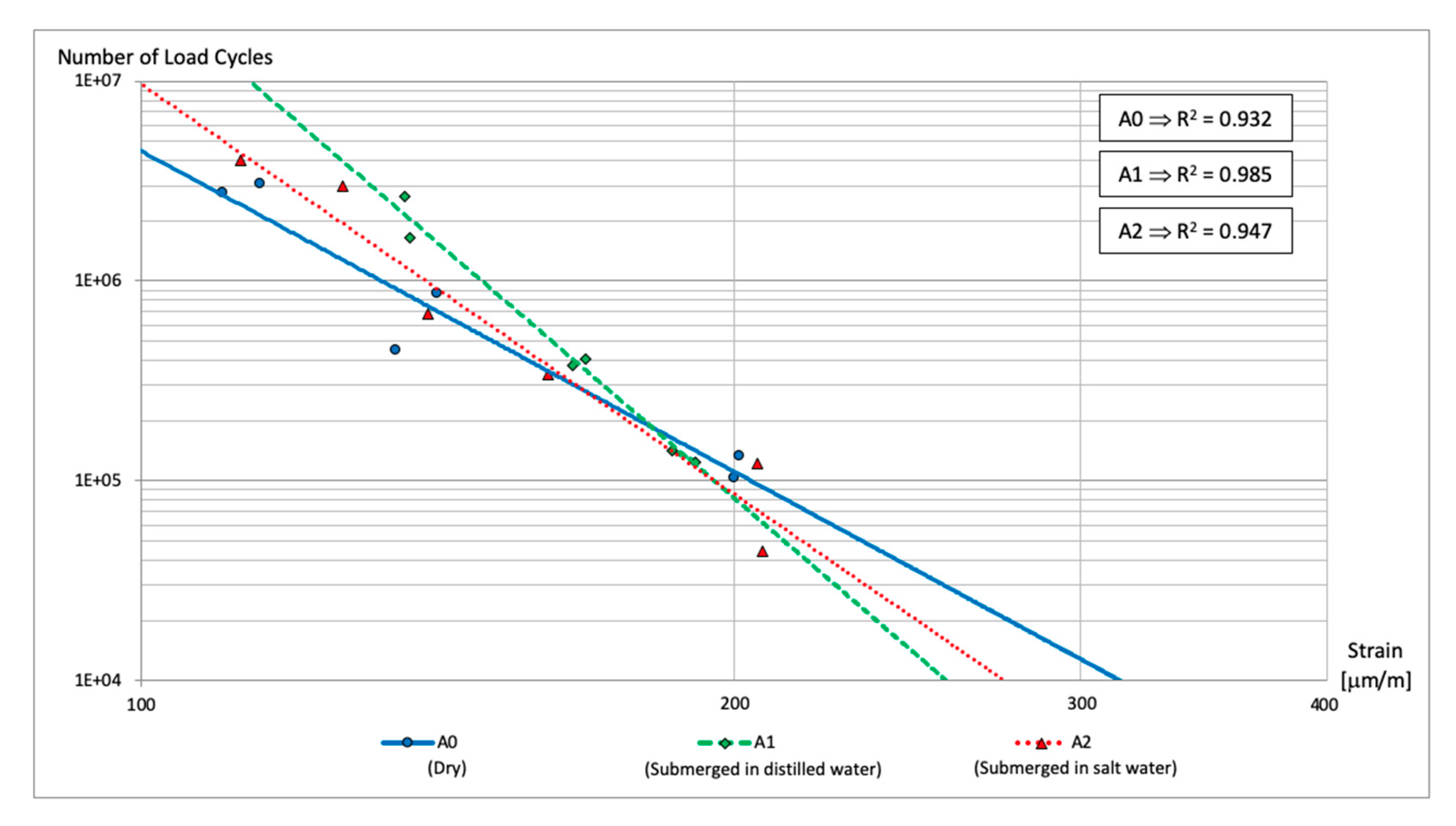
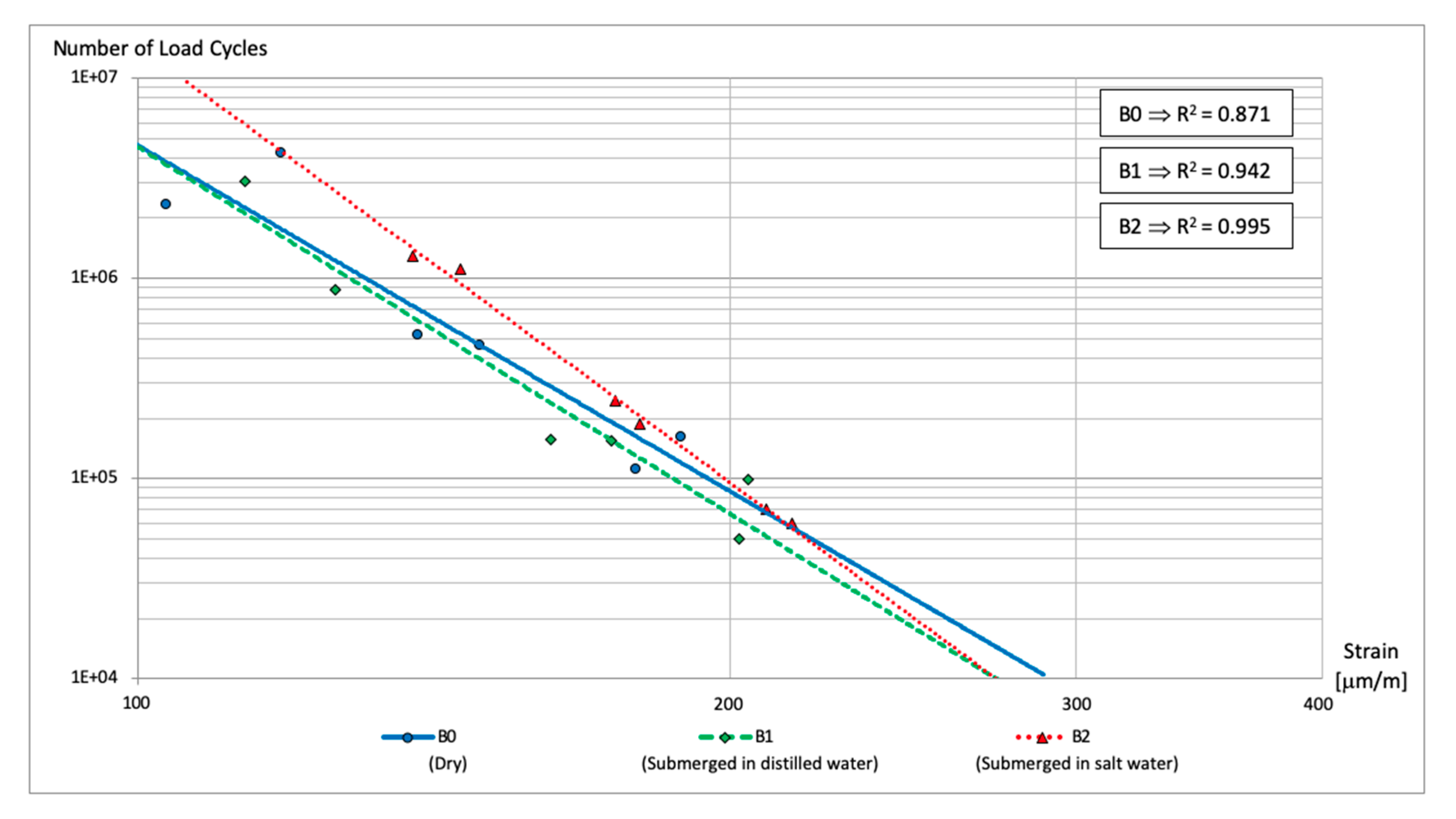
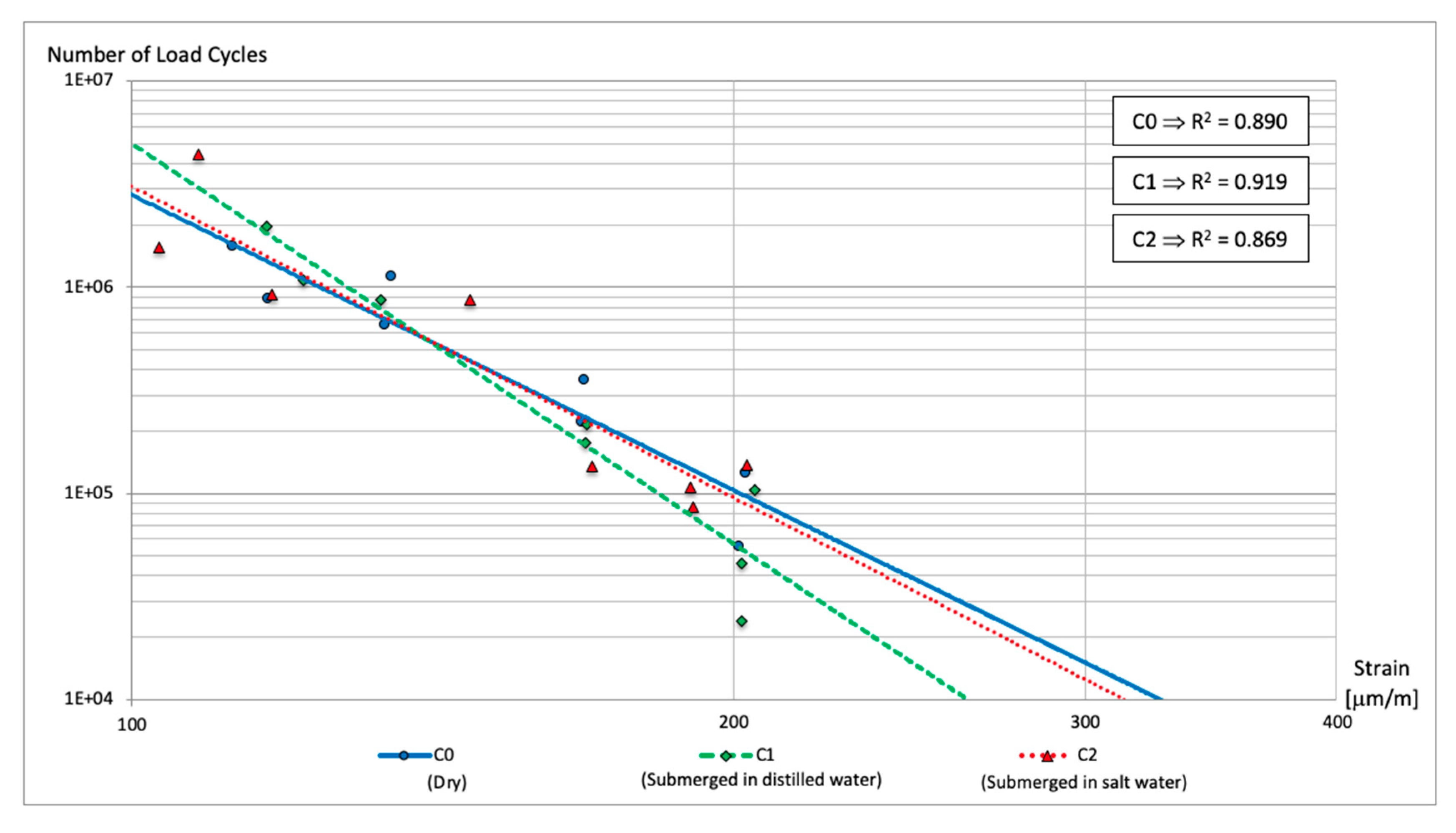
| Aggregate | Los Angeles Abrasion Test (%) (UNE-EN 1097-2:2010) [22] | Water Absorption (%) (UNE-EN 1097-6:2014) [23] | Flakiness Index (%) (UNE-EN 933-3:2012) [24] |
|---|---|---|---|
| Ophite | 16.0 | 1.0 | 9.0 |
| Bitumen | Penetration (25 °C; 100 g, 5 s) (0.1 mm) (UNE-EN 1426:2015) [25] | Softening Point (°C) (UNE-EN 1427:2015) [26] | Frass Breaking Point (°C) (UNE-EN 12593:2015) [27] |
|---|---|---|---|
| B 50/70 | 65.0 | 47.2 | −9 |
| Passing Rate (%) | Bitumen Content s/m (%) | ||||||||
|---|---|---|---|---|---|---|---|---|---|
| Sieve size (mm) | 22 | 16 | 8 | 4 | 2 | 0.5 | 0.25 | 0.063 | |
| AC16 Surf D | 100.0 | 95.0 | 71.5 | 51.5 | 38.5 | 21.5 | 15.5 | 6.0 | 5.0 |
| Passing Rate (%) | ||||||||
|---|---|---|---|---|---|---|---|---|
| Sieve Size (mm) | 22 | 16 | 8 | 4 | 2 | 0.5 | 0.25 | 0.063 |
| Salt | 100.0 | 100.0 | 100.0 | 100.0 | 100.0 | 74.9 | 39.9 | 6.6 |
| Water Interaction | ||||
|---|---|---|---|---|
| Dry | Submerged in Distilled Water | Submerged in Salt Water | ||
| Temperature interaction | Constant temperature at 20 °C | A0 | A1 | A2 |
| Five freeze–thaw cycles | B0 | B1 | B2 | |
| One year outside storage | C0 | C1 | C2 | |
| Series | AC16 Surf B 50/70 D | |||
|---|---|---|---|---|
| Maximum Load (kN) | ITSR (%) | |||
| Constant temperature at 20 °C | A0 | 2340 | − | − |
| A1 | − | 2075 | 89 | |
| A2 | − | 2053 | 88 | |
| Five Freeze–Thaw Cycles | B0 | 2385 | − | − |
| B1 | − | 1540 | 63 | |
| B2 | − | 1975 | 83 | |
| One year outside storage | C0 | 2189 | − | − |
| C1 | − | 1418 | 65 | |
| C2 | − | 1690 | 77 | |
| Series | AC16 Surf B 50/70 D | |
|---|---|---|
| WTS (mm/103 Cycles) | ||
| Constant temperature at 20 °C | A0 | 0.08 |
| A1 | 0.07 | |
| A2 | 0.05 | |
| One year outside storage | C0 | 0.06 |
| C1 | 0.04 | |
| C2 | 0.08 |
| Series | AC16 Surf B 50/70 D | |
|---|---|---|
| RD (mm) | ||
| Constant temperature at 20 °C | A0 | 3.2 |
| A1 | 3.6 | |
| A2 | 2.4 | |
| One year outside storage | C0 | 2.6 |
| C1 | 2.1 | |
| C2 | 3.0 |
| Series | AC16 Surf B 50/70 D | ||||||||||
|---|---|---|---|---|---|---|---|---|---|---|---|
| Frequency (Hz) | |||||||||||
| 0.1 | 0.2 | 0.5 | 1.0 | 2.0 | |||||||
| E (GPa) | Phase Angle (°) | E (GPa) | Phase Angle (°) | E (GPa) | Phase Angle(°) | E (GPa) | Phase Angle (°) | E (GPa) | Phase Angle (°) | ||
| Constant temperature at 20 °C | A0 | 2.4 | 32.8 | 2.9 | 30.5 | 3.7 | 27.0 | 4.4 | 24.9 | 5.2 | 22.6 |
| A1 | 2.2 | 33.8 | 2.7 | 31.2 | 3.5 | 27.5 | 4.1 | 25.1 | 4.9 | 23.2 | |
| A2 | 2.1 | 34.7 | 2.6 | 32.1 | 3.5 | 28.4 | 4.2 | 26.1 | 5.0 | 24.0 | |
| Five Freeze–Thaw Cycles | B0 | 2.2 | 35.9 | 2.7 | 33.2 | 3.5 | 30.0 | 4.3 | 27.4 | 5.1 | 25.2 |
| B1 | 1.7 | 34.8 | 2.2 | 32.1 | 2.9 | 28.9 | 3.5 | 26.8 | 4.1 | 24.6 | |
| B2 | 2.0 | 33.0 | 2.5 | 30.5 | 3.3 | 27.1 | 4.0 | 25.0 | 4.7 | 23.0 | |
| One year outside storage | C0 | 2.4 | 31.3 | 2.9 | 28.9 | 3.7 | 26.0 | 4.4 | 23.9 | 5.2 | 21.9 |
| C1 | 2.2 | 33.1 | 2.6 | 30.6 | 3.4 | 27.5 | 4.1 | 25.4 | 4.8 | 23.3 | |
| C2 | 2.2 | 34.0 | 2.8 | 31.2 | 3.6 | 28.0 | 4.3 | 25.8 | 5.1 | 23.6 | |
| Series | AC16 Surf B 50/70 D | ||||||||||
|---|---|---|---|---|---|---|---|---|---|---|---|
| Frequency (Hz) | |||||||||||
| 5.0 | 8.0 | 10.0 | 20.0 | 30.0 | |||||||
| E (GPa) | Phase Angle (°) | E (GPa) | Phase Angle (°) | E (GPa) | Phase Angle (°) | E (GPa) | Phase Angle (°) | E (GPa) | Phase Angle (°) | ||
| Constant temperature at 20 °C | A0 | 6.2 | 20.3 | 6.9 | 19.0 | 7.1 | 18.5 | 8.1 | 17.0 | 8.9 | 16.5 |
| A1 | 6.0 | 20.7 | 6.6 | 19.2 | 6.9 | 18.6 | 7.9 | 17.6 | 8.7 | 16.6 | |
| A2 | 6.1 | 21.3 | 6.7 | 20.0 | 7.0 | 19.3 | 8.0 | 17.8 | 8.9 | 17.6 | |
| Five Freeze–Thaw Cycles | B0 | 6.3 | 22.4 | 7.0 | 21.1 | 7.3 | 20.5 | 8.5 | 18.8 | 9.2 | 17.8 |
| B1 | 5.1 | 21.9 | 5.7 | 20.6 | 5.9 | 19.9 | 6.9 | 18.6 | 7.5 | 17.7 | |
| B2 | 5.8 | 20.3 | 6.4 | 19.2 | 6.6 | 18.6 | 7.8 | 17.7 | 8.5 | 16.6 | |
| One year outside storage | C0 | 6.4 | 19.6 | 6.9 | 18.4 | 7.2 | 17.6 | 8.5 | 16.8 | 9.2 | 15.9 |
| C1 | 5.9 | 20.8 | 6.5 | 19.5 | 6.9 | 19.1 | 7.9 | 18.6 | 8.4 | 16.2 | |
| C2 | 6.2 | 21.1 | 6.9 | 19.7 | 7.2 | 19.1 | 8.3 | 17.9 | 8.9 | 16.8 | |
© 2020 by the authors. Licensee MDPI, Basel, Switzerland. This article is an open access article distributed under the terms and conditions of the Creative Commons Attribution (CC BY) license (http://creativecommons.org/licenses/by/4.0/).
Share and Cite
Vega-Zamanillo, Á.; Juli-Gándara, L.; Calzada-Pérez, M.Á.; Teijón-López-Zuazo, E. Impact of Temperature Changes and Freeze—Thaw Cycles on the Behaviour of Asphalt Concrete Submerged in Water with Sodium Chloride. Appl. Sci. 2020, 10, 1241. https://doi.org/10.3390/app10041241
Vega-Zamanillo Á, Juli-Gándara L, Calzada-Pérez MÁ, Teijón-López-Zuazo E. Impact of Temperature Changes and Freeze—Thaw Cycles on the Behaviour of Asphalt Concrete Submerged in Water with Sodium Chloride. Applied Sciences. 2020; 10(4):1241. https://doi.org/10.3390/app10041241
Chicago/Turabian StyleVega-Zamanillo, Ángel, Luis Juli-Gándara, Miguel Ángel Calzada-Pérez, and Evelio Teijón-López-Zuazo. 2020. "Impact of Temperature Changes and Freeze—Thaw Cycles on the Behaviour of Asphalt Concrete Submerged in Water with Sodium Chloride" Applied Sciences 10, no. 4: 1241. https://doi.org/10.3390/app10041241
APA StyleVega-Zamanillo, Á., Juli-Gándara, L., Calzada-Pérez, M. Á., & Teijón-López-Zuazo, E. (2020). Impact of Temperature Changes and Freeze—Thaw Cycles on the Behaviour of Asphalt Concrete Submerged in Water with Sodium Chloride. Applied Sciences, 10(4), 1241. https://doi.org/10.3390/app10041241






